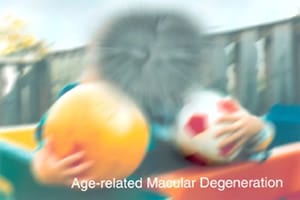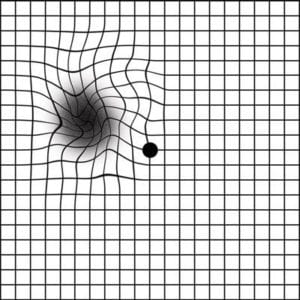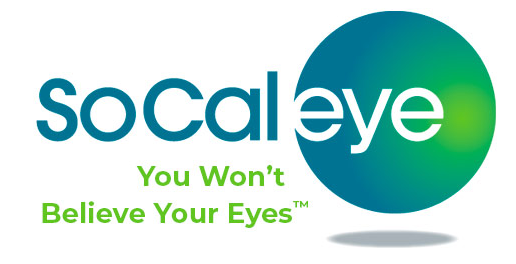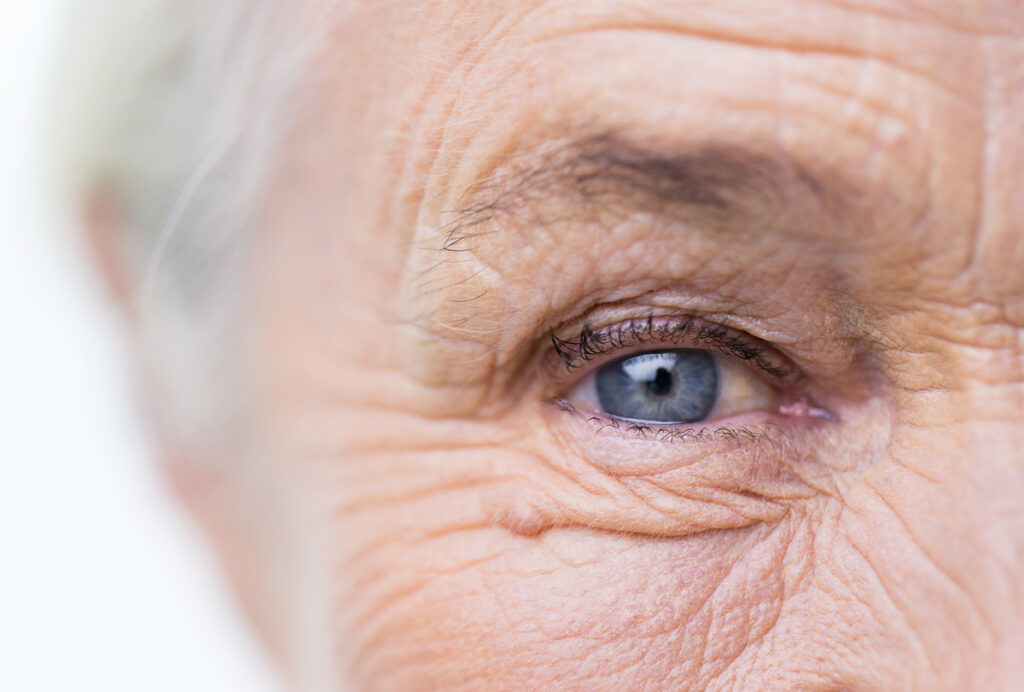SoCal Eye – Age Related Macular Degeneration Specialist in Long Beach.
Macular degeneration—simply described as blurred vision—is a leading cause of vision loss among people 50 and older, affecting more than 10 million Americans. If you think you may be among them, be glad to know that macular degeneration, or AMD, can be easily detected. There are even ways to reduce or slow its onset but early detection and treatment are critical. The experienced Eye Physicians at SoCal Eye have been working with Age Related Macular Degeneration in Long Beach, Huntington Beach and Garden Grove since 1964. Treatment starts with a Comprehensive Eye Exam. Schedule an Appointment today at LAKEWOOD (562) 531-2020 | LOS ALAMITOS (562) 598-7728 or send us an Online Consultation Request
What is Aged Related Macular Degeneration?
 Age-related macular degeneration (AMD) is a disease associated with aging that can gradually destroy sharp, central vision. Central vision is needed for seeing objects clearly and for common daily tasks such as reading and driving. Macular degeneration never causes one to go “black blind.” Almost everyone with AMD, including those with severe cases, can maintain a significant degree of autonomy and independence.
Age-related macular degeneration (AMD) is a disease associated with aging that can gradually destroy sharp, central vision. Central vision is needed for seeing objects clearly and for common daily tasks such as reading and driving. Macular degeneration never causes one to go “black blind.” Almost everyone with AMD, including those with severe cases, can maintain a significant degree of autonomy and independence.
AMD affects the macula. The macula is located in the center of the retina, the light-sensitive tissue at the back of the eye. The retina instantly converts light, or an image, into electrical impulses. The retina then sends these impulses, or nerve signals, to the brain.
In some cases, AMD advances so slowly that people notice little change in their vision. In others, the disease progresses faster and may lead to a loss of central vision in both eyes. AMD is a leading cause of legal vision loss in Americans 60 years of age and older. It is probably found, to some degree, in everyone over 65 years old.
There are Two Types of Age Related Macular Degeneration:
- Dry
- Wet
Dry Macular Degeneration:
Dry AMD occurs when the light-sensitive cells in the macula slowly break down, gradually blurring central vision in the affected eye. As dry AMD gets worse, you may see a blurred spot in the center of your vision. Over time, as less of the macula functions, central vision can be gradually lost in the affected eye.
The most common symptom of dry AMD is slightly blurred vision. You may have difficulty recognizing faces. You may need more light for reading and other tasks. Dry AMD generally affects both eyes, but vision can be lost in one eye while the other eye seems unaffected.
If you have vision loss from AMD in one eye only, you may not notice any changes in your overall vision. With the other eye seeing clearly, you can still drive, read, and see fine details. You may notice changes in your vision only if AMD affects both eyes. If blurriness occurs in your vision, the staff at SoCal Eye will be more than happy to offer a complete examination and explanation of the cause. There are no specific treatments for dry AMD; fortunately, significant vision loss from dry AMD is rare.
Wet Macular Degeneration:
After dry AMD has developed, the retina may become brittle and allow underlying blood vessels to creep into the overlying retina. These blood vessels can damage the retina by bleeding, leaking, or direct injury. Wet ADM can be treated by medication or laser, if it is detected early.
Which form of AMD is more common, the dry form or the wet form? The dry form is much more common. More than 85 percent of all people with intermediate and advanced AMD have the dry form.
Can the dry form turn into the wet form? Yes. All people who have the wet form had the dry form first. The dry form can advance and cause changes to the central vision without turning into the wet form. The dry form also can suddenly turn into the wet form, even during early stage AMD. There is no way to tell if or when the dry form will turn into the wet form.
Macular Degeneration – Causes & Risk Factors:
Who is at Risk for AMD?
The greatest risk factor is age. Although AMD may occur during middle age, studies show that people over age 60 are clearly at greater risk than other age groups. Many feel that everyone develops some AMD eventually, although it may never become visually significant.
Other Risk Factors for Macular Degeneration:
- Smoking – Smoking may increase the risk of AMD.
- Obesity – Research studies suggest a link between obesity and the progression of early- and intermediate-stage AMD to advanced AMD.
- Race – Caucasians are much more likely to lose vision from AMD than African Americans.
- Family history – Those with immediate family members who have AMD are at a higher risk of developing the disease.
- Gender – Women appear to be at greater risk than men.
Can my lifestyle make a difference? Your lifestyle can play a role in reducing your risk of developing AMD. At SoCal Eye, we recommend that you:
- Eat a healthy diet high in green leafy vegetables and fish.
- Don’t smoke.
- Maintain normal blood pressure and cholesterol levels.
- Watch your weight.
- Exercise.
- Consider vitamin supplements.
- Perform daily Amsler grid testing, as noted below.
Macular Degeneration – Symptoms & Detection:
Symptoms for Aged Related Macular Degeneration:
Both dry and wet AMD cause no pain.
- Dry: the most common early sign is blurred vision. As fewer cells in the macula are able to function, people will see fine details less clearly, such as faces or words in a book. Often this blurred vision will go away in brighter light. If the loss of these light-sensing cells becomes great, people may see a small—but growing—blind spot in the middle of their field of vision.
- Wet: the classic early symptom is that straight lines appear crooked. This results when fluid from the leaking blood vessels gathers and lifts the macula, distorting vision. A small blind spot may also appear in wet AMD, resulting in loss of one’s central vision.
Detection:
Macular Degeneration doctors at SoCal Eye can detect AMD by performing a comprehensive eye exam. During an eye exam, you may be asked to look at an Amsler grid. The pattern of the grid resembles a checkerboard. You will cover one eye and stare at a black dot in the center of the grid. While staring at the dot, you may notice that the straight lines in the pattern appear wavy. You may notice that some of the lines are missing. These may be signs of AMD.
In addition to performing a physical eye exam, we also use sophisticated instruments to image the retina and allow the doctors to actually see the layers of the retina as if they were looking through a microscope. The images are similar to those obtained by an MRI, but the testing is done in the office and only takes about 60 seconds.
Amsler Grid:

Distortion on this grid may indicate a problem with your macula. However, seeing a normal grid does not preclude
AMD. Daily usage of an Amsler grid is often the earliest and easiest way for patients to monitor and detect wet AMD. Early detection of AMD is key to getting the best results from treatment.
Using the Amsler Grid to test your vision: Put on reading glasses, cover one eye, position yourself about 18 inches from the grid and stare at the dot in the center. You should be able to see the dot, the lines should be straight, and the squares should be square. If they are not, and the changes are new, please make an appointment with us or your eye care professional to be seen as soon as possible; do not wait more than a couple of days.
Macular Degeneration – Treatment:
How is Wet AMD treated?
At SoCal Eye, we have doctors who are fellowship trained in the treatment of diseases of the retina, including macular degeneration. We have all the latest technologies and techniques at our disposal to allow optimal results. Wet AMD can be treated with laser surgery, photodynamic therapy, and injections into the eye. None of these treatments is a cure for wet AMD. The disease and loss of vision may progress despite treatment.
- Laser surgery – This procedure uses a laser to destroy the fragile, leaky blood vessels. A high energy beam of light is aimed directly onto the new blood vessels and destroys them, preventing further loss of vision. However, laser treatment may also destroy some surrounding healthy tissue and some vision. Only a small percentage of people with wet AMD can be treated with laser surgery. Laser surgery is performed in the office.
- Photodynamic therapy – A drug called verteporfin is injected into your arm. It travels throughout the body, including the new blood vessels in your eye. The drug tends to “stick” to the surface of new blood vessels. Next, a light is shined into your eye for 90 seconds. The light activates the drug. The activated drug destroys the new blood vessels and leads to a slower rate of vision decline. Unlike laser surgery, this drug does not destroy surrounding healthy tissue. Because the drug is activated by light, you must avoid exposing your skin or eyes to direct sunlight or bright indoor light for five days after treatment. Photodynamic therapy is relatively painless. It takes 20 minutes and can be performed in our office. Photodynamic therapy slows the rate of vision loss. It does not stop vision loss or restore vision in eyes already damaged by advanced AMD. Treatment results often are temporary. You may need to be treated again.
- Injections – Wet AMD can now be treated with new drugs that are injected into the eye (anti-VEGF therapy). Abnormally high levels of a specific growth factor occurs in eyes with wet AMD and promotes the growth of abnormal new blood vessels. These drugs block the effects of the growth factor. Multiple injections are often needed, usually once a month. The eye is numbed before each injection, and most patients report only mild pressure or discomfort. This drug treatment can help slow down vision loss from AMD and, in some cases, improve sight.
What can be done if AMD becomes advanced?
Once dry AMD reaches the advanced stage, no form of treatment can return what has been lost. However, treatment can delay and possibly prevent intermediate AMD from progressing to the advanced stage, in which vision loss occurs.
The National Eye Institute found that taking a specific high-dose formulation of antioxidants and zinc significantly reduces the risk of advanced AMD and its associated vision loss. Slowing AMD’s progression from the intermediate stage to the advanced stage will save the vision of many people.
SoCal Eye Consultation:
The key to success with Treatment for Aged Related Macular Degeneration is Early Detection. If it can be caught early through a Comprehensive Eye Exam, the progression of the disease can be slowed dramatically. SoCal Eye doctors are the Macular Degeneration Specialists in Long Beach. Schedule an Appointment today at LAKEWOOD (562) 531-2020 | LOS ALAMITOS (562) 598-7728 or send us an Online Consultation Request




